Science nuggets - Solar Orbiter
High-Resolution Observations of Clustered Dynamic Extreme-Ultraviolet Bright Tadpoles near the Footpoints of Coronal Loops
(Solar Orbiter Nugget #58 by R. Wang1,2, Y. D. Liu1,2, L. P. Chitta3, X. Zhao4,5 and Huidong Hu1)
1. Introduction
The European Space Agency's (ESA) Solar Orbiter (SO) [1], launched in February 2020, has ushered in a groundbreaking era of solar observation by capturing high-resolution images from unprecedented proximity to the Sun. On March 26, 2022, SO reached its perihelion, i.e. the closest approach to the Sun, positioning the spacecraft within Mercury's orbit, at roughly one-third of the Sun-Earth distance. This vantage point enhanced the capabilities of the High Resolution Imager (HRIEUV) instrument, part of the Extreme Ultraviolet Imager (EUI) suite, which boasts an angular pixel resolution of 0.492''. By March 30, 2022, HRI achieved a remarkable spatial resolution of 118 kilometers on the solar surface, among the highest ever recorded by the mission. This exceptional resolution has enabled scientists to observe intricate details of the Sun's atmosphere, revealing previously unseen small-scale structures and offering fresh insights into solar dynamics.
2. Stereoscopic Measurements
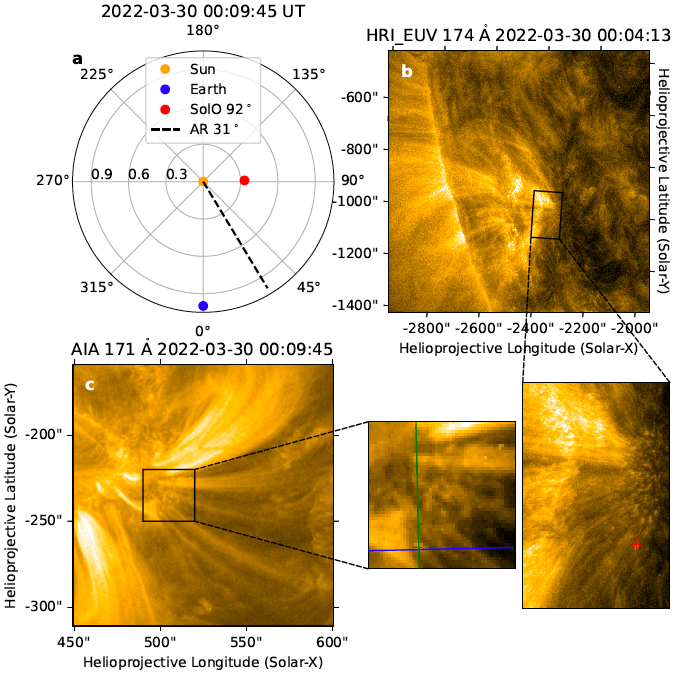
Figure 1. Stereoscopic measurements using SDO and SO. (a) Heliospheric positions of planets and spacecraft. (b) and (c) CEBTs observed from EUI/HRIEUV and AIA views with localized zoomed inserts, respectively. The red crosses and the intersecting green and blue lines in the inserts represent stereoscopic measurements using the two instruments. Animation of the inserts is available.
Using the HRI's 174 Å channel, we identified clusters of dynamic, tadpole-like structures near the footpoints of coronal loops where magnetic field lines anchor into the solar surface. Named "Clustered Extreme-Ultraviolet Bright Tadpoles" (CEBTs) due to their elongated tails and grouped appearance (see Figure 2a) and 2b below), these features often exhibit downward motion. Observations of multi-instruments from SO indicate that they may occur above the edge of the weak magnetic field region around the coronal loops. To measure their heights, we employed a stereoscopic technique, also used to estimate the height of "campfires" [2], by combining near-simultaneous observations from SO's HRIEUV and the Solar Dynamics Observatory's (SDO) Atmospheric Imaging Assembly (AIA) at 171 Å. This method, illustrated in Figure 1, leverages the differing perspectives of the two spacecraft to triangulate the altitudes of these structures. Analysis of six typical CEBTs revealed heights ranging from approximately 1,300 to 3,300 km, spanning the chromosphere, transition region, and lower corona.
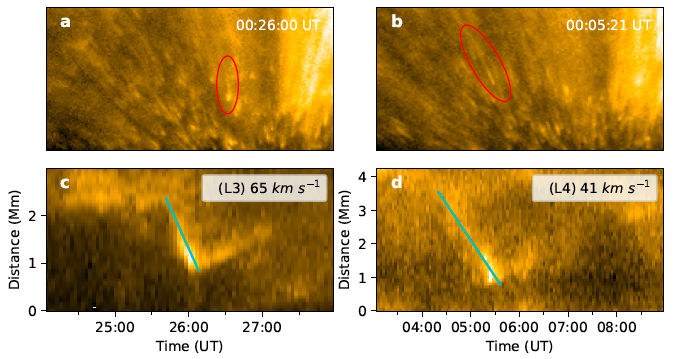
Figure 2. Velocity measurements of D-CEBTs. (a) and (b) Typical tadpole-shaped D-CEBT structures. The times are the SO time. (c) and (d) Corresponding time-distance plots of D-CEBTs, with downward- moving velocities annotated by cyan lines.
3. Discussion and conclusions
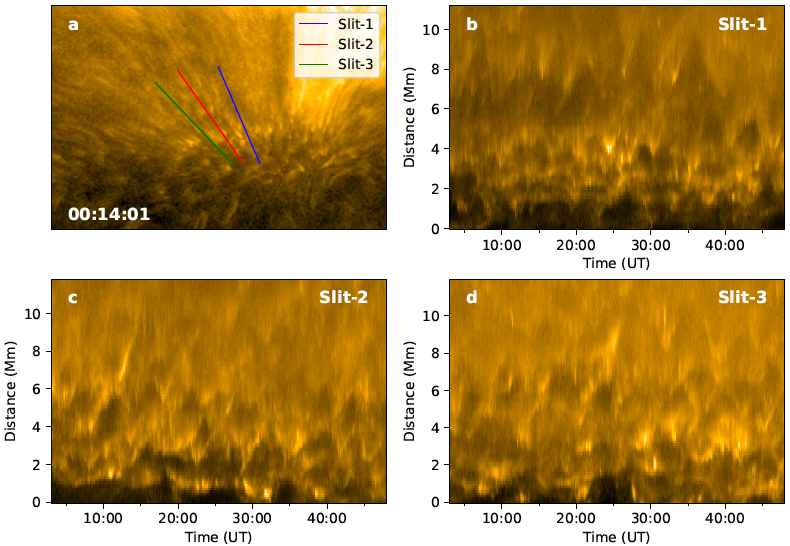
Figure 3. The periodic measurements of dark and cooler filamentary structures associated with CEBTs. (a) Lines in different colors represent the artificial slits used for generating time-distance plots, depicted in panels (b)-(d). The directions of the slits are from bottom right to top left. Animation of (a) is available.
The discovery of CEBTs reveals new complexities in the Sun's lower atmosphere, distinguishing these features from known phenomena such as microjets or campfires. These structures are classified into upward-moving (U-CEBTs) and downward-moving (D-CEBTs) types, with D-CEBTs being more prevalent. Time-distance analyses (see Figure 3) reveal that CEBTs exhibit periodic oscillations with cycles of 3-5 minutes, resembling the behavior of Type I spicules [3] or coronal fibrils [4], jet-like features in the chromosphere known for their oscillatory motion. However, D-CEBTs display downward velocities reaching up to 70 km s-1, far exceeding the typical speeds of Type I spicules (< 50 km s-1) and aligning more closely with Type II spicules [3][5][6] or coronal rain descent velocities [7][8].
This intriguing combination of characteristics has sparked several hypotheses. One suggests that CEBTs may combine characteristics of both Type I and Type II spicules, displaying a hybrid nature [5][6]. Another posits a connection to micro-scale coronal rain, though the lack of the cool, dense plasma clumps typical of coronal rain challenges this idea [7]. The rapid downward motion of D-CEBTs, observed in the extreme-ultraviolet (EUV) band, is particularly intriguing. While EUV studies often highlight the upward motion of spicules [9], the downward phase has received less focus, making CEBTs potentially significant for advancing our understanding of solar atmospheric dynamics. As Solar Orbiter continues to deliver high-resolution data, future studies promise to unravel the origins and significance of these enigmatic tadpole-like structures, deepening our understanding of the Sun's complex atmosphere.
This study has been published in R. Wang, et al. 2024, Research in Astronomy and Astrophysics, 24, 125010.
Affiliations
(1) State Key Laboratory of Solar Activity and Space Weather, National Space Science Center, Chinese Academy of Sciences, Beijing 100190, People's Republic of China
(2) University of Chinese Academy of Sciences, Beijing 100049, People's Republic of China
(3) Max-Planck-Institut für Sonnensystemforschung, Justus-von-Liebig-Weg 3, 37077 Göttingen, Germany
(4) Key Laboratory of Space Weather, National Satellite Meteorological Center (National Center for Space Weather), China Meteorological Administration, Beijing 100081, People's Republic of China
(5) School of Earth and Space Sciences, Peking University, Beijing 100871, People's Republic of China
References
[1] Muller, D., St. Cyr, O. C., Zouganelis, I. et al. 2020, A&A, 642, 1, doi: https://doi.org/10. 1051/0004-6361/202038467
[2] Berghmans, D., Antolin, P., Auchere, F., et al. 2023, A&A, 675, A110, https://doi.org/10. 1051/0004-6361/202140380
[3] De Pontieu, B., McIntosh, S., Hansteen, V. H., et al. 2007, PASJ, 59, S655, doi: http: //doi.org/10.1093/pasj/59.sp3.S655
[4] Mandal, S., Peter, H., Chitta, L. P., et al. 2023a, A&A, 678, L5, doi: https://doi.org/10. 1051/0004-6361/202245431
[5] De Pontieu, B., McIntosh, S., Carlsson, M., et al. 2011, Sci, 331, 55, doi: http://doi.org/10. 1126/science.1197738
[6] Pereira, T. D., De Pontieu, B., Carlsson, M., et al. 2014, ApJL, 792, L15, doi:http://dx.doi. org/10.1088/2041-8205/792/1/L15
[7] Li, X., Keppens, R., & Zhou, Y. 2022, ApJ, 926, 216, doi: https://doi.org/10.3847/ 1538-4357/ac41cd
[8] Antolin, P., Dolliou, A., Auchere, F., et al. 2023, A&A, 676, A112, doi: https://doi.org/10. 1051/0004-6361/202346016 7
[9] Samanta, T., Tian, H., Yurchyshyn, V., et al. 2019, Science, 366, 890, doi: http://doi.org/ 10.1126/science.aaw2796
Acknowledgements
The research was supported by National Key R&D Program of China No. 2022YFF0503800 and No. 2021YFA0718600, the Strategic Priority Research Program of the Chinese Academy of Sciences (NO. XDB0560000), NSFC under grants 12073032, 42274201, 42150105, and 42204176, and the Specialized Research Fund for State Key Laboratories of China. We acknowledge the use of data from Solar Orbiter and SDO. Solar Orbiter is a space mission of international collaboration between ESA and NASA, operated by ESA. The EUI instrument was built by CSL, IAS, MPS, MSSL/UCL, PMOD/WRC, ROB, LCF/IO with funding from the Belgian Federal Science Policy O ce (BELSPO/PRODEX PEA 4000134088); the Centre National d'Etudes Spatiales (CNES); the UK Space Agency (UKSA); the Bundesministerium für Wirtschaft und Energie (BMWi) through the Deutsches Zentrum für Luft- und Raumfahrt (DLR); and the Swiss Space O ce (SSO). L.P.C. gratefully acknowledges funding by the European Union (ERC, ORIGIN, 101039844). Views and opinions expressed are however those of the author(s) only and do not necessarily re ect those of the European Union or the European Research Council. Neither the European Union nor the granting authority can be held responsible for them.
Nuggets archive
2025
09/04/2025: Bursty acceleration and 3D trajectories of electrons in a solar flare
02/04/2025: Picoflare jets in the coronal holes and their link to the solar wind
19/03/2025: Radial dependence of solar energetic particle peak fluxes and fluences
12/03/2025: Analysis of solar eruptions deflecting in the low corona
05/03/2025: Propagation of particles inside a magnetic cloud: Solar Orbiter insights
19/02/2025: Rotation motions and signatures of the Alfvén waves in a fan-spine topology
12/02/2025: 'Sun'day everyday: 2 years of Solar Orbiter science nuggets that shed light on some of our star's mysteries
22/01/2025: Velocity field in the solar granulation from two-vantage points
15/01/2025: First joint X-ray solar microflare observations with NuSTAR and Solar Orbiter/STIX
2024
18/12/2024: Shocks in tandem : Solar Orbiter observes a fully formed forward-reverse shock pair in the inner heliosphere
11/12/2024: High-energy insights from an escaping coronal mass ejection
04/12/2024: Investigation of Venus plasma tail using the Solar Orbiter, Parker Solar Probe and Bepi Colombo flybys
27/11/2024: Testing the Flux Expansion Factor – Solar Wind Speed Relation with Solar Orbiter data
20/11/2024:The role of small scale EUV brightenings in the quiet Sun coronal heating
13/11/2024: Improved Insights from the Suprathermal Ion Spectrograph on Solar Orbiter
30/10/2024: Temporally resolved Type III solar radio bursts in the frequency range 3-13 MHz
23/10/2024: Resolving proton and alpha beams for improved understanding of plasma kinetics: SWA-PAS observations
25/09/2024: All microflares that accelerate electrons to high-energies are rooted in sunspots
25/09/2024: Connecting Solar Orbiter and L1 measurements of mesoscale solar wind structures to their coronal source using the Adapt-WSA model
18/09/2024: Modelling the global structure of a coronal mass ejection observed by Solar Orbiter and Parker Solar Probe
28/08/2024: Coordinated observations with the Swedish 1m Solar Telescope and Solar Orbiter
21/08/2024: Multi-source connectivity drives heliospheric solar wind variability
14/08/2024: Composition Mosaics from March 2022
19/06/2024: Coordinated Coronal and Heliospheric Observations During the 2024 Total Solar Eclipse
22/05/2024: Real time space weather prediction with Solar Orbiter
15/05/2024: Hard X ray and microwave pulsations: a signature of the flare energy release process
01/02/2024: Relativistic electrons accelerated by an interplanetary shock wave
11/01/2024: Modelling Two Consecutive Energetic Storm Particle Events observed by Solar Orbiter
2023
14/12/2023: Understanding STIX hard X-ray source motions using field extrapolations
16/11/2023: EUI data reveal a "steady" mode of coronal heating
09/11/2023: A new solution to the ambiguity problem
02/11/2023: Solar Orbiter and Parker Solar Probe jointly take a step forward in understanding coronal heating
25/10/2023: Observations of mini coronal dimmings caused by small-scale eruptions in the quiet Sun
18/10/2023: Fleeting small-scale surface magnetic fields build the quiet-Sun corona
27/09/2023: Solar Orbiter reveals non-field-aligned solar wind proton beams and its role in wave growth activities
20/09/2023: Polarisation of decayless kink oscillations of solar coronal loops
23/08/2023: A sharp EUI and SPICE look into the EUV variability and fine-scale structure associated with coronal rain
02/08/2023: Solar Flare Hard Xrays from the anchor points of an eruptive filament
28/06/2023: 3He-rich solar energetic particle events observed close to the Sun on Solar Orbiter
14/06/2023: Observational Evidence of S-web Source of Slow Solar Wind
31/05/2023: An interesting interplanetary shock
24/05/2023: High-resolution imaging of coronal mass ejections from SoloHI
17/05/2023: Direct assessment of far-side helioseismology using SO/PHI magnetograms
10/05/2023: Measuring the nascent solar wind outflow velocities via the doppler dimming technique
26/04/2023: Imaging and spectroscopic observations of EUV brightenings using SPICE and EUI on board Solar Orbiter
19/04/2023: Hot X-ray onset observations in solar flares with Solar Orbiter/STIX
12/04/2023: Multi-scale structure and composition of ICME prominence material from the Solar Wind Analyser suite
22/03/2023: Langmuir waves associated with magnetic holes in the solar wind
15/03/2023: Radial dependence of the peak intensity of solar energetic electron events in the inner heliosphere
08/03/2023: New insights about EUV brightenings in the quiet sun corona from the Extreme Ultraviolet Imager
Bursty acceleration and 3D trajectories of electrons in a solar flare
(Solar Orbiter Nugget #57 by S. Bhunia1,2, L. A. Hayes3, K. L. Klein4,5, N. Vilmer4,5, S. A. Maloney1 and P. T. Gallagher1)
1. Introduction
Solar flares are sudden explosions occurring in the Sun’s atmosphere due to reconnection of magnetic field lines and emit radiation across the electromagnetic spectrum, from radio end even up to gamma ray frequencies. During the flare, accelerated electrons propagate upwards and downwards from the energy release site along magnetic field lines and produce radio and hard X-ray (HXR) emission. Sometimes, we have simultaneous observations of HXR flux with many peaks and multiple fine structures in radio emission at decimetric and metric wavelengths during the flare [1]. The temporal correlation between these two kinds of emission suggests that the electrons producing these emissions have the same acceleration origin [2,3,4]. Past works [5,6,7] also proposed that the multiple HXR fine structures and multiple radio bursts are possibly the observational signatures of several fragmented energy releases during solar flares. Hence, we combine X-ray observations from the Spectrometer/Telescope for Imaging X-rays (STIX) onboard Solar Orbiter together with ground-based radio observations during a flare to show the evidence of bursty acceleration and study the trajectories of the flare accelerated electron beams in the low solar corona.
2. Event Overview

Fig. 1:(a) STIX X-ray spectrogram with the time series of the summed non-thermal energy bands overplotted on top of it. The plot shows the three major non-thermal periods. (b), (c), and (d) show the type III bursts observed by ORFEES, I-LOFAR, and WAVES in the frequency range.
On 11 November 2022, a strong solar flare (M1.2 GOES flare) was observed while Solar Orbiter was at a heliocentric distance of 0.62 AU and 21.8 deg to the east from the Sun-Earth line. Fig 1 shows the flare as observed by X-rays with STIX (top panel) and radio observations in the bottom panels across a large range of frequencies from the Observations Radio pour Fedome et l’Etude des Eruptions Solaires (ORFEES) radio spectrograph, Irish Low Frequency Array (I-LOFAR), and the space-based instrument Radio and Plasma Wave Investigation (WAVES) on board the WIND spacecraft . STIX X-ray spectrogram clearly shows three major non-thermal periods (P1, P2, and P3) seen in the HXR energy ranges. Several HXR spikes are also seen within each period. In addition, there were simultaneous observations of multiple radio bursts including type III bursts, signatures of flare accelerated electron beams propagating along open field lines. Comparing the X-ray with radio spectra, one can see that there exists a good temporal association between the individual HXR period at 15-25 keV and the groups of radio bursts. In general, it is seen that during each non-thermal period as the HXR emission increases the starting frequency of the associated radio bursts also increases. This is because the increase of HXR flux implies there are more high energetic electron beams for which it is easier to produce the radio emission at much lower heights; that is, at higher starting frequencies.
3. Signatures of electron acceleration
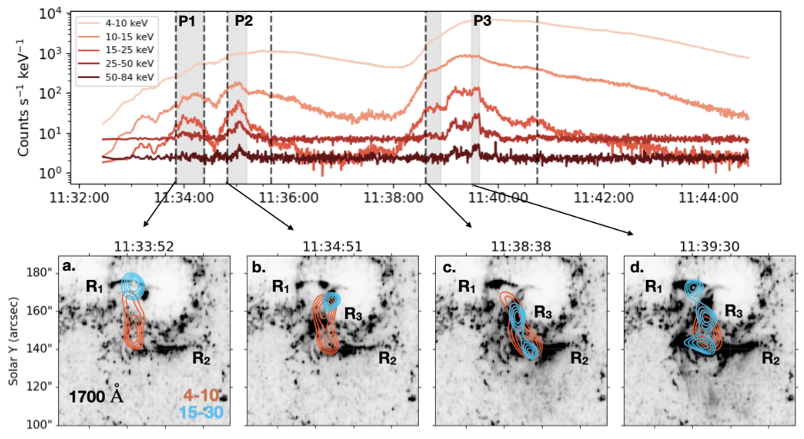
Fig. 2. The top panel shows the STIX time series in five energy bands. The bottom panel shows the flare evolution in 1700 Å, during each of the non-thermal peaks. Overlaid on top of each image are the reprojected thermal (4-10 keV, red) and non-thermal (15-30 keV, sky blue) contours of the STIX images using the MEM_GE method.
To investigate each of the major HXR non-thermal peaks, we constructed images using STIX observations. X-ray imaging (Fig. 2) during these non-thermal peaks shows one, two, or three HXR sources at different locations implying that there are several injections of electrons at different locations. Also, in the 1700 Å image (Fig. 3d), both the ribbon R2 and the HXR source are observed to extend towards the east. Hence, the morphology of the magnetic structure has likely changed based on the location of the ribbons and the HXR sources.
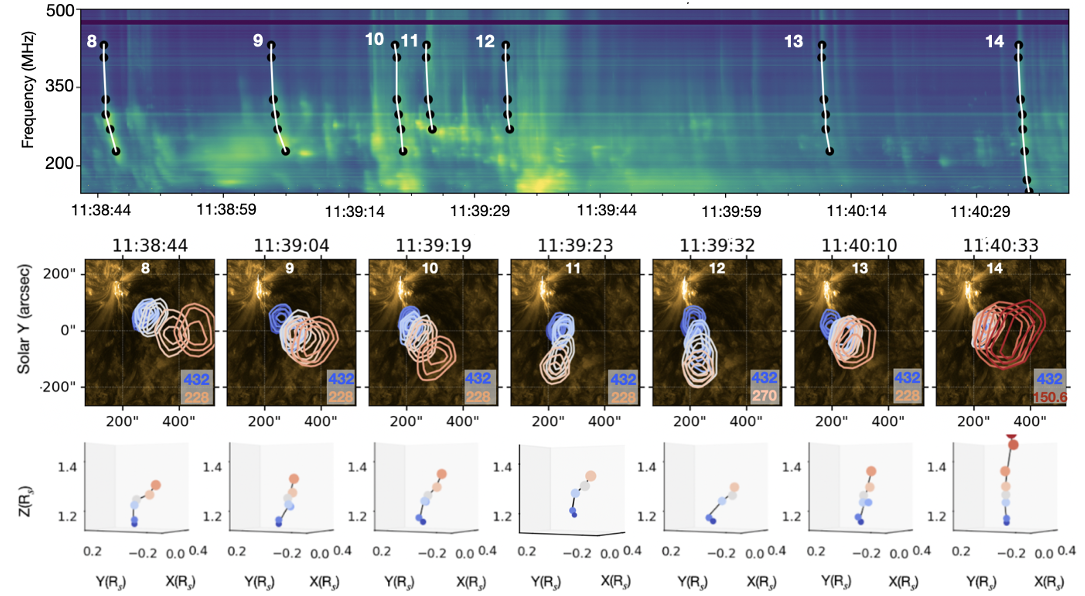
Fig. 3. The top panel shows the dynamic spectra from 11:38:42-11:40:38 UT. Here we identify three different types of bursts: a) the type IIIs with sharp cutoff (B8 & B9), b) diffuse type IIIs (B10, B11 & B12) & individual type IIIs (B13 & B14). The middle panel shows the sources for each burst overplotted on AIA images whereas the bottom panel shows the 3D trajectory for each burst.
To track the accelerated electrons in the upper corona that produce the radio emission, the trajectories of the radio bursts in 3D were constructed using Nançay Radioheliograph (NRH) and the Newkirk density model [8]. The top panel of Fig 3 shows the detailed spectra of radio bursts during P3. The middle and bottom panel show the imaging and 3D trajectories of each of these bursts. It is clear that the propagation paths of these bursts are different. Fig. 4 shows the trajectories of the bursts during P2 and P3 together. Different propagation paths are indicated by different colors and circles on individual trajectories mark the source locations at different frequencies for the bursts. Both figures show clear evidence that the trajectories of the exciters differ between individual bursts. This indicates that after acceleration, electron beams travel along different closed or open field lines. The right plot shows the clear positional shift of starting location of the radio bursts during P3. The general difference in the starting location of these bursts compared to the previous bursts and the correlated change in HXR source location suggests that the acceleration location of the electrons responsible for these emissions has shifted.
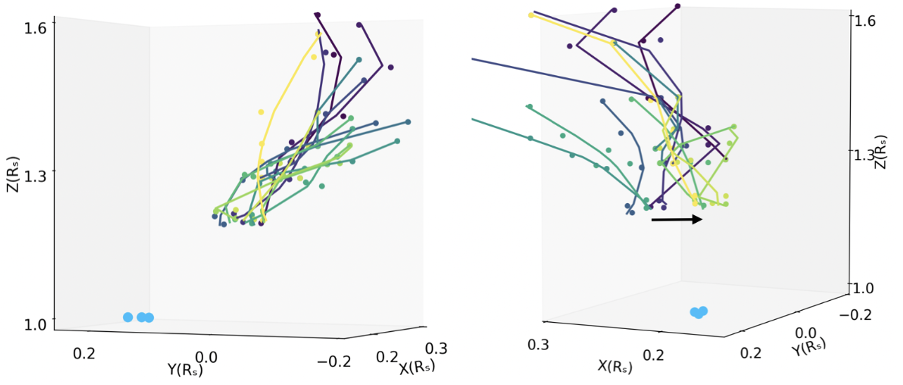
Fig. 4. The left and right plots show the 3D trajectories of all 14 radio bursts under two different viewing angles. In the right figure, one can see the shift of the radio sources at 432 MHz for bursts during P3 indicated by the arrow.
4. Conclusions
In this study, we have tracked the flare-accelerated electrons from the chromosphere to the upper corona using EUV, X-ray, and radio observations. We have found many coronal bursts associated with several HXR non-thermal peaks. X-ray imaging shows several HXR sources indicating multiple acceleration processes during the flare. NRH imaging and 3D trajectories of the radio bursts show that electrons are getting accelerated at different locations and propagate along various distinct field lines. Hence, we conclude that the flare acceleration process is very fragmented temporally and spatially. STIX and NRH imaging also show correlated changes in the location of HXR and radio sources, indicating that the acceleration source of the X-ray and radio-emitting electrons is common.
For further reading, please see the publication: S. Bhunia et al., Bursty acceleration and 3D trajectories of electrons in a solar flare, A&A, 695, A135 (2025)
Affiliations
(1) Astronomy & Astrophysics Section, Dublin Institute for Advanced Studies, Dublin, D02 XF86, Ireland.
(2) School of Physics, Trinity College Dublin, College Green, Dublin 2, Ireland.
(3) European Space Agency, ESTEC, Keplerlaan 1 - 2201 AZ, Noordwijk, The Netherlands.
(4) LIRA, Observatoire de Paris, PSL Research University, CNRS, Sorbonne Université, Université Paris Cité, 5 place Jules Janssen, 92195 Meudon, France
(5) Observatoire Radioastronomique de Nançay, Observatoire de Paris, PSL Research University, CNRS, Univ. Orléans, 18330 Nançay, France
References
[1] Pick, M. & Vilmer, N. 2008, The Astronomy and Astrophysics Review, 16, 1
[2] Aschwanden, M. J., Montello, M. L., Dennis, B. R., & Benz, A. O. 1995b, ApJ,440, 394
[3] Vilmer, N., Krucker, S., Lin, R. P., & The Rhessi Team. 2002, Solar Physics, 210,261
[4] James, T. & Vilmer, N. 2023, A&A, 673, A57
[5] Vlahos, L. & Raoult, A. 1995, A&A, 296, 844
[6] Isliker, H., Vlahos, L., Benz, A. O., & Raoult, A. 1998, A&A, 336, 371
[7] Cargill, P. J., Vlahos, L., Baumann, G., Drake, J. F., & Nordlund, Å. 2012,Space Sci. Rev., 173, 223
[8] Newkirk, Gordon, J. 1961, ApJ, 133, 983
The Sun seen by Solar Orbiter
Latest EUI/FSI data
Latest Metis data
Visible-light polarized brightness
Visible-light total brightness
UV H I Lyman-α
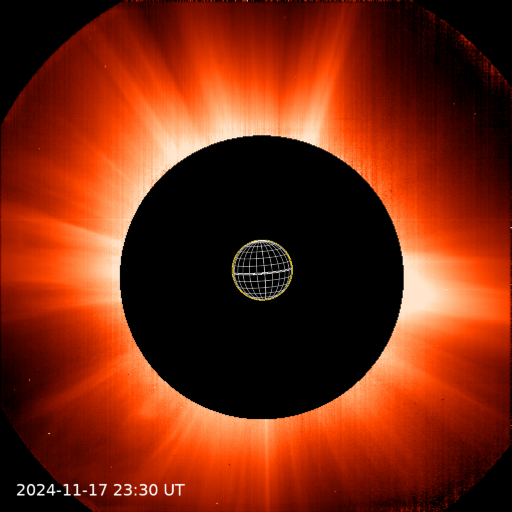

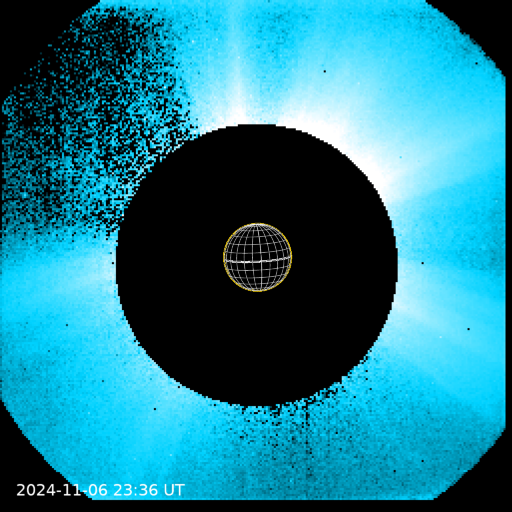
The Sun seen by Solar Dynamics Observatory (AIA)
The Sun seen by GOES / SUVI
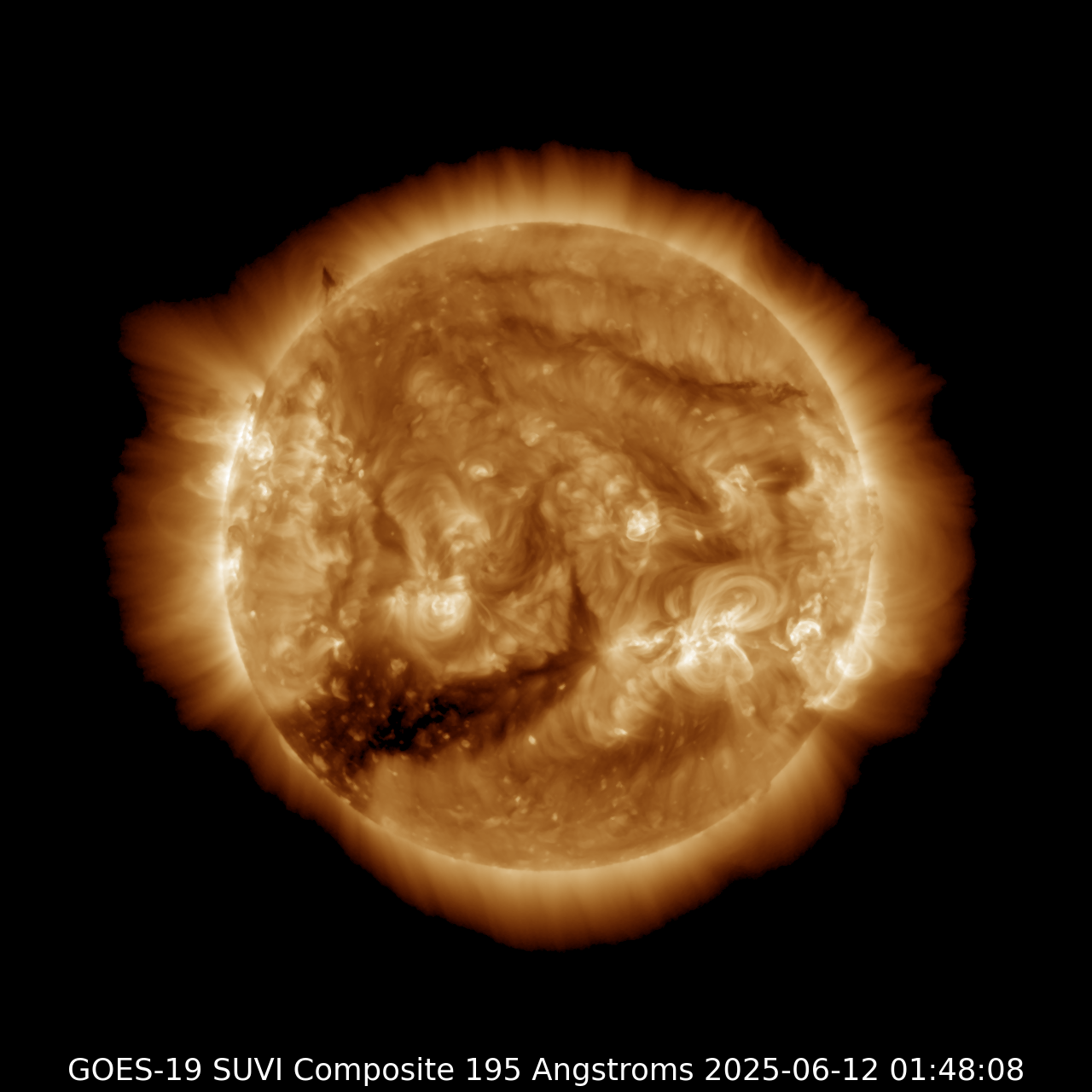
- Removed a total of (1) style margin:0;
Solar Wind monitoring by Solar Orbiter
Latest MAG data

Latest SWA data
Latest EPD data
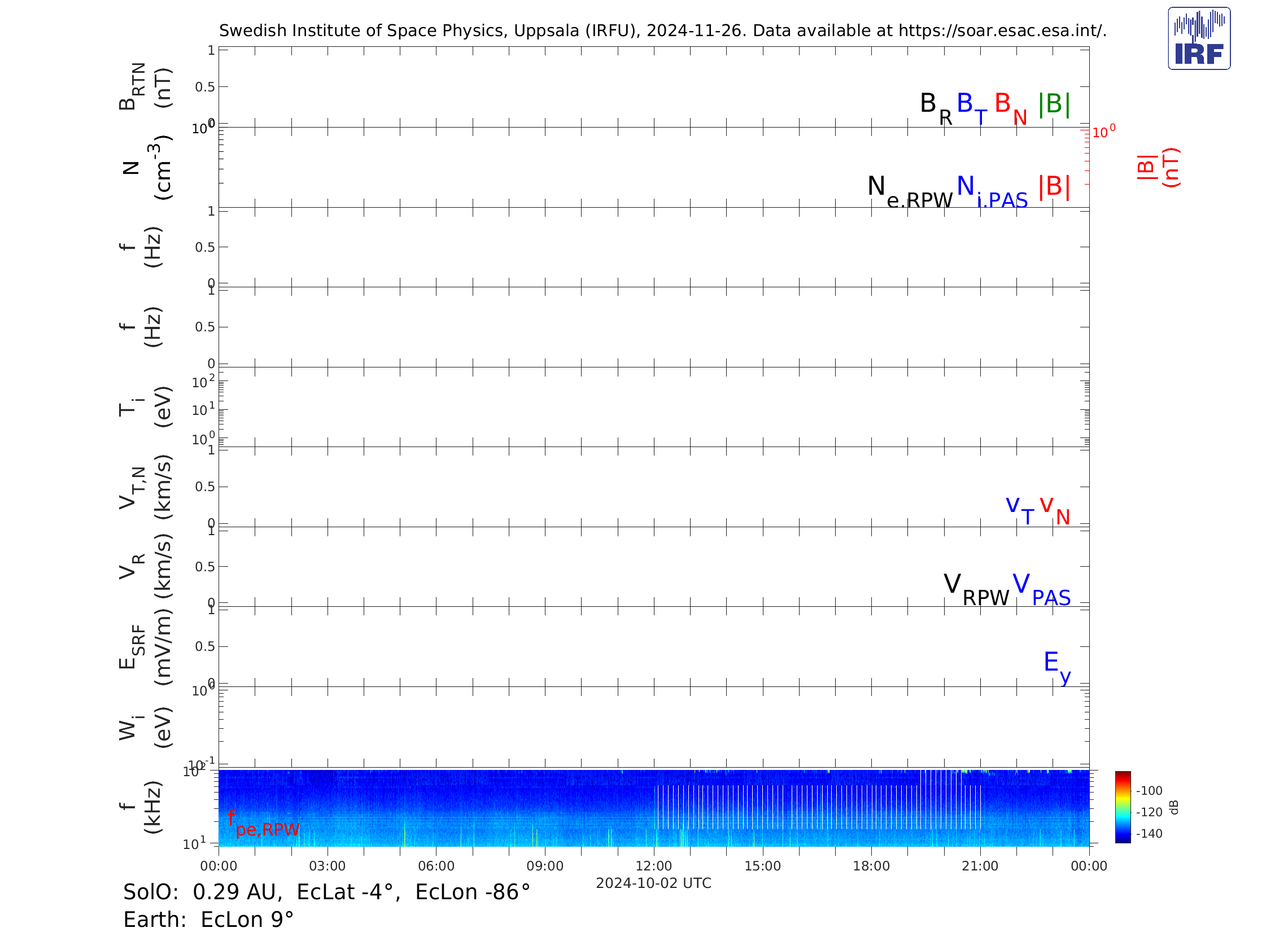
-->
Solar Orbiter Community building Webinars
They aim is to provide recent news and insights on the Solar Orbiter operations and science.
They will be held on Webex every 1st Wednesday of every month, at 2:00pm European Central Time.
Click here for the Webinars registration
Future webinars
Webinar #8, 7th May 2025 (30'): Observations of solar energetic particle events with Solar Orbiter and friends: new results and open-source analysis tools. With Nina Dresing (Turku University)
Webinar #9, 4th June 2025 (30'): What do we learn from Solar Orbiter and Parker Solar Probe working together in the inner heliosphere. With Yeimy Rivera (CfA)
Webinar #10, 2nd July 2025 (30'): The dynamic Sun in high-resolution, from nanoflares to prominences. With Susanna Parenti (IAS)
Past webinars
Webinar #1, 2nd October 2024 (1h): Introduction to the Solar Orbiter mission: the science, the data, and the SunPy ecosystem. With Daniel Müller (ESA/ESTEC) and Laura Hayes (ESA/ESTEC)
Link to Daniel Müller's presentation
Link to Laura Hayes's presentation
Link to the form request for the webinar #1 recordings
(Notice: All information provided in the form request are treated confidentially and are only used for anonymised statistics.)
Webinar #2, 6th November 2024 (30'): Small-scale heating and relation to the solar wind: a review of Solar Orbiter observations. With Pradeep Chitta (MPS)
Link to Pradeep Chitta's presentation
Link to the form request for the webinar #2 recordings
(Notice: All information provided in the form request are treated confidentially and are only used for anonymised statistics.)
Webinar #3 was rescheduled to Webinar #5 due to a technical issue.
Webinar #4, 8th January 2025 (30'): Synergies between in situ and remote-sensing science with Solar Orbiter. With Daniel Verscharen (MSSL/UCL)
Link to Daniel Verscharen's presentation
Link to the form request for the webinar #4 recording
Webinar #5, 5th February 2025 (30'): Solar Wind connectivity with Solar Orbiter. With Stephanie Yardley (Northumbria University) (Rescheduled from 4th December 2024)
Link to Steph Yardley's presentation
Link to the form request for the webinar #5 recording
Webinar #6, 5th March 2025 (30'): Combining in-situ and remote-sensing data from Solar Orbiter to study particle acceleration and transport in the heliosphere. With Alexander Warmuth (AIP)
Link to Alexander Warmuth's presentation
Link to the form request for the webinar #6 recording
Webinar #7, 2nd April 2025 (30'): What can we learn from looking at the corona with Solar Orbiter. With Clementina Sasso (INAF)
Link to Clemetina Sasso's presentation
Link to the form request for the webinar #7 recording
Nuggets archive
2025
09/04/2025: Bursty acceleration and 3D trajectories of electrons in a solar flare
02/04/2025: Picoflare jets in the coronal holes and their link to the solar wind
19/03/2025: Radial dependence of solar energetic particle peak fluxes and fluences
12/03/2025: Analysis of solar eruptions deflecting in the low corona
05/03/2025: Propagation of particles inside a magnetic cloud: Solar Orbiter insights
19/02/2025: Rotation motions and signatures of the Alfvén waves in a fan-spine topology
12/02/2025: 'Sun'day everyday: 2 years of Solar Orbiter science nuggets that shed light on some of our star's mysteries
22/01/2025: Velocity field in the solar granulation from two-vantage points
15/01/2025: First joint X-ray solar microflare observations with NuSTAR and Solar Orbiter/STIX
2024
18/12/2024: Shocks in tandem : Solar Orbiter observes a fully formed forward-reverse shock pair in the inner heliosphere
11/12/2024: High-energy insights from an escaping coronal mass ejection
04/12/2024: Investigation of Venus plasma tail using the Solar Orbiter, Parker Solar Probe and Bepi Colombo flybys
27/11/2024: Testing the Flux Expansion Factor – Solar Wind Speed Relation with Solar Orbiter data
20/11/2024:The role of small scale EUV brightenings in the quiet Sun coronal heating
13/11/2024: Improved Insights from the Suprathermal Ion Spectrograph on Solar Orbiter
30/10/2024: Temporally resolved Type III solar radio bursts in the frequency range 3-13 MHz
23/10/2024: Resolving proton and alpha beams for improved understanding of plasma kinetics: SWA-PAS observations
25/09/2024: All microflares that accelerate electrons to high-energies are rooted in sunspots
25/09/2024: Connecting Solar Orbiter and L1 measurements of mesoscale solar wind structures to their coronal source using the Adapt-WSA model
18/09/2024: Modelling the global structure of a coronal mass ejection observed by Solar Orbiter and Parker Solar Probe
28/08/2024: Coordinated observations with the Swedish 1m Solar Telescope and Solar Orbiter
21/08/2024: Multi-source connectivity drives heliospheric solar wind variability
14/08/2024: Composition Mosaics from March 2022
19/06/2024: Coordinated Coronal and Heliospheric Observations During the 2024 Total Solar Eclipse
22/05/2024: Real time space weather prediction with Solar Orbiter
15/05/2024: Hard X ray and microwave pulsations: a signature of the flare energy release process
01/02/2024: Relativistic electrons accelerated by an interplanetary shock wave
11/01/2024: Modelling Two Consecutive Energetic Storm Particle Events observed by Solar Orbiter
2023
14/12/2023: Understanding STIX hard X-ray source motions using field extrapolations
16/11/2023: EUI data reveal a "steady" mode of coronal heating
09/11/2023: A new solution to the ambiguity problem
02/11/2023: Solar Orbiter and Parker Solar Probe jointly take a step forward in understanding coronal heating
25/10/2023: Observations of mini coronal dimmings caused by small-scale eruptions in the quiet Sun
18/10/2023: Fleeting small-scale surface magnetic fields build the quiet-Sun corona
27/09/2023: Solar Orbiter reveals non-field-aligned solar wind proton beams and its role in wave growth activities
20/09/2023: Polarisation of decayless kink oscillations of solar coronal loops
23/08/2023: A sharp EUI and SPICE look into the EUV variability and fine-scale structure associated with coronal rain
02/08/2023: Solar Flare Hard Xrays from the anchor points of an eruptive filament
28/06/2023: 3He-rich solar energetic particle events observed close to the Sun on Solar Orbiter
14/06/2023: Observational Evidence of S-web Source of Slow Solar Wind
31/05/2023: An interesting interplanetary shock
24/05/2023: High-resolution imaging of coronal mass ejections from SoloHI
17/05/2023: Direct assessment of far-side helioseismology using SO/PHI magnetograms
10/05/2023: Measuring the nascent solar wind outflow velocities via the doppler dimming technique
26/04/2023: Imaging and spectroscopic observations of EUV brightenings using SPICE and EUI on board Solar Orbiter
19/04/2023: Hot X-ray onset observations in solar flares with Solar Orbiter/STIX
12/04/2023: Multi-scale structure and composition of ICME prominence material from the Solar Wind Analyser suite
22/03/2023: Langmuir waves associated with magnetic holes in the solar wind
15/03/2023: Radial dependence of the peak intensity of solar energetic electron events in the inner heliosphere
08/03/2023: New insights about EUV brightenings in the quiet sun corona from the Extreme Ultraviolet Imager








































 Sign in
Sign in
 Science & Technology
Science & Technology